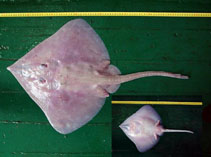| Family: |
Arhynchobatidae (Softnose skates) |
| Max. size: |
170 cm TL (male/unsexed) |
| Environment: |
bathypelagic; marine; depth range 111 - 2949 m |
| Distribution: |
North Atlantic and adjacent Arctic. |
| Diagnosis: |
Disk without spines, except near edge of pectoral fins in males. Ventral mucous pores not blackish. Tail with middorsal row of large spines. Snout pointed (Ref. 7251). Upper surface pale brown or bluish gray without dark markings. Lower surface white with small sooty blotches irregularly distributed around margins of pectorals, pelvic fins white below. Lower surface of tail white but pale brown rearward (Ref. 6902). |
| Biology: |
An inhabitant of deep, cold water (Ref. 7251). Benthic (Ref. 58426). Feed on all kinds of bottom animals (Ref. 3167). Oviparous (Ref. 50449). Distinct pairing with embrace. Young may tend to follow large objects, such as their mother (Ref. 205). Eggs are oblong capsules with stiff pointed horns at the corners deposited in sandy or muddy flats (Ref. 205). Egg capsules are 13.4-16.5 cm long and 8.0-10.2 cm wide (Ref. 41251, 41301). This species is part of the regular by-catch of deep-sea fisheries (Ref. 117245). |
| IUCN Red List Status: |
Near Threatened (NT); Date assessed: 18 June 2019 (A2bcd) Ref. (130435)
|
| Threat to humans: |
harmless |
Source and more info: www.fishbase.org. For personal, classroom, and other internal use only. Not for publication.

